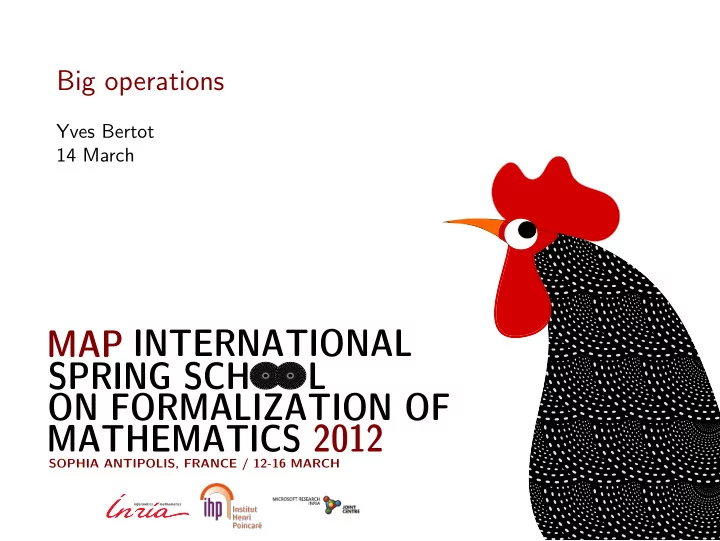

Big operations Yves Bertot 14 March MAP INTERNATIONAL SPRING SCH L ON FORMALIZATION OF MATHEMATICS 2012 SOPHIA ANTIPOLIS, FRANCE / 12-16 MARCH
Iterating binary operations Binary operations abound in mathematics Big operations generalize to n-ary applications Many features or big operations are common A systematic treatement of the infrastructure Yves Bertot Big operations
Notations Special cases \sum (i < n) f i , \prod (j <= k < n) g i well typed if f g : nat -> nat , f : ’I n -> nat Possibility to filter \sum (i < n | odd i) f i Ways to choose the operator and starting value \big[op/id] (i < n | P i) f i \sum (i < | odd i) f i = \big[addn/0] (i < n | odd i) f i Yves Bertot Big operations
Ranges \sum (i < n) F i the type of i in F i is ’I n : this brings information The elements are taken in increasing order \sum (i < n | P i) F i \sum (i \in odd5) F i if odd5 is a collective predicate on a finite type \prod i F i if the domain of F is a finite type \sum (m <= i < n) F i \big[op/v] (i <- s) F i Finite types, intervals, and sequences come with a natural order Yves Bertot Big operations
Plain operators Some theorems don’t rely on any property from the operator Empty ranges : big nil , big ord0 , big geq Predicate not satisfied: big hasC , big pred0 Detaching the leftmost value : big cons , big ltn Range format switching : big nth Widening range: big *widen , big *narrow Exchanging function and predicate : eq big , eq bigl , eq bigr Look for section Extensionality in bigop.v Yves Bertot Big operations
Example Section test. Variables (op1 : nat -> nat -> nat) (v : nat). Lemma cmp_op3 : \big[op1/v]_(1 <= i < 3) i = op1 1 (op1 2 v). rewrite big_ltn. =============== op1 1 \big[op1/v]_(2 <= i < 3) i = op1 (op 2 v). subgoal 2 is: 1 < 3 rewrite big_ltn; last by [] =============== op1 1 (op1 2 \big[op1/v]_(3 <= i < 3) i) = op1 (op2 v) rewrite big_geq; last by [] op1 1 (op1 2 v) = op1 1 (op1 2 v) Yves Bertot Big operations
Monoid structures Cut range in two, start from the right, big cat , big cat nat big nat recr , big ord recr , only without filter Replacing all absent elements with the neutral big mkcond big_mkcond : forall ... , \big[*%M/1]_(i <- r | P i) F i = \big[*%M/1]_(i <- r) (if P i then F i else 1). Yves Bertot Big operations
Example with monoid structures Lemma s3’ : \sum_(i < 3) i = 3. rewrite big_ord_recr. =============== addn_monoid (\big[addn_monoid/0]_(i < 2) widen_ord (m:=3) (leqnSn 2) i) ord_max = 3 rewrite big_ord_recr /=. =============== \sum_(i < 1) i + 1 + 2 = 3 Yves Bertot Big operations
Abelian structures Divide arbitrarily, partition, re-order, pick one element big_split : forall ... (op : Monoid.com_law idx) ..., \big[op/idx]_(i <- r | P i) op (F1 i) (F2 i) = op (\big[op/idx]_(i <- r | P i) F1 i) (\big[op/idx]_(i <- r | P i) F2 i) Exchange big operations exchange_big : forall ..., \big[op/idx]_(i | P i) \big[op/idx]_(j | Q j) F i j = \big[op/idx]_(j | Q j) \big[op/idx]_(i | P i) F i j. Yves Bertot Big operations
Example with re-indexing Lemma sumnP : forall n, \sum_(i < n) i = (n * n.-1) %/2. suff <- : 2 * \sum_(i < n) i = n * n.-1 by rewrite mulKn. Continue in a demonstration!! Yves Bertot Big operations
Distributivity Distributivity concerns the exchange of two operations Multiplication by a scalar, but also by a big sum. ( a 1 , 1 + a 1 , 2 + a 1 , 3 )( a 2 , 1 + a 2 , 2 + a 2 , 3 ) = � � a ( i , f ( i )) f ∈{ 1 , 2 , 3 } { 1 , 2 }} i ∈{ 1 , 2 } We can range over all functions because it is also a fintype. Scalar: big distrr , sums: big distr big Also with dependent choices Yves Bertot Big operations
Properties Properties satisfied by elements and preserved by operators are satisfied big_prop : forall ... , Pb idx -> (forall x y : R, Pb x -> Pb y -> Pb (op1 x y)) -> (forall i : I, P i -> Pb (F i)) -> Pb (\big[op1/idx]_(i <- r | P i) F i) Similar theorem big rel to relate two big operations Advised use: elim/big prop: and elim/big rel: Caveat: the name of these theorems will change in future versions of SSReflect . Yves Bertot Big operations
Morphisms When phi is a morphism between two monoid structures big_morph: forall ... , { morph phi : x y / op1 x y >-> op2 x y } -> phi idx1 = idx2 -> phi (\big[op1/idx1]_(i <- r | P i) F i) = \big[op2/idx2]_(i <- r | P i) phi (F i) Demonstration if time allows Yves Bertot Big operations
think big Available for any list, binary operation, and value Specific theorems require specific properties big nat recr requires associativity Properties are attached to operators using canonical structures For associativity: Monoid.law. Canonical Structure op2Mon : Monoid.law 0 := Monoid.Law op2A op20n op2n0. op2A , op20n and op2n0 would have to be proofs that some operation ( op2 ) is associative and that some element (0) is left neutral and right neutral for this operation. Demonstration if time allows. Yves Bertot Big operations
Recommend
More recommend